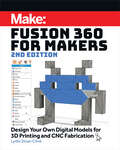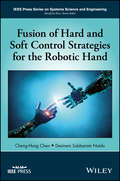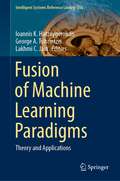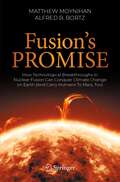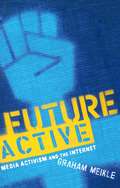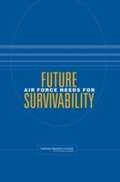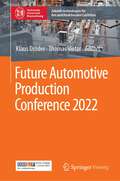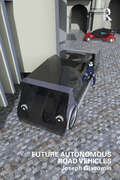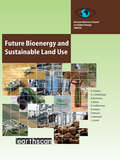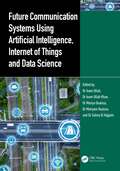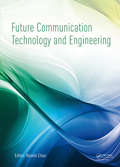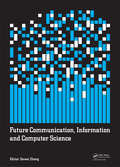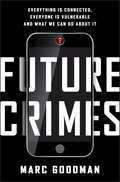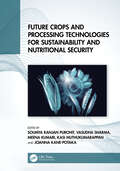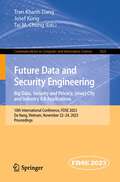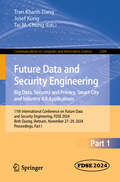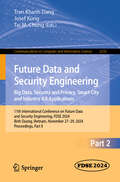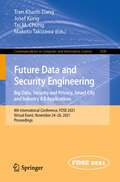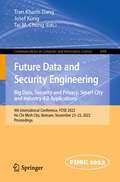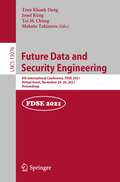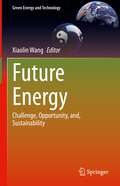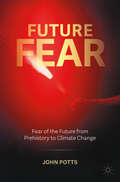- Table View
- List View
Fusion 360 for Makers: Design Your Own Digital Models for 3D Printing and CNC Fabrication
by Lydia Sloan ClineLearn how to use Autodesk Fusion 360 to digitally model your own original projects for a 3D printer or a CNC device.
Fusion of Hard and Soft Control Strategies for the Robotic Hand
by Cheng-Hung Chen Desineni Subbaram NaiduAn in-depth review of hybrid control techniques for smart prosthetic hand technology by two of the world’s pioneering experts in the field Long considered the stuff of science fiction, a prosthetic hand capable of fully replicating all of that appendage’s various functions is closer to becoming reality than ever before. This book provides a comprehensive report on exciting recent developments in hybrid control techniques—one of the most crucial hurdles to be overcome in creating smart prosthetic hands. Coauthored by two of the world’s foremost pioneering experts in the field, Fusion of Hard and Soft Control Strategies for Robotic Hand treats robotic hands for multiple applications. Itbegins withan overview of advances in main control techniques that have been made over the past decade before addressing the military context for affordable robotic hand technology with tactile and/or proprioceptive feedback for hand amputees. Kinematics, homogeneous transformations, inverse and differential kinematics, trajectory planning, and dynamic models of two-link thumb and three-link index finger are discussed in detail. The remainder of the book is devoted to the most promising soft computing techniques, particle swarm optimization techniques, and strategies combining hard and soft controls. In addition, the book: Includes a report on exciting new developments in prosthetic/robotic hand technology, with an emphasis on the fusion of hard and soft control strategies Covers both prosthetic and non-prosthetic hand designs for everything from routine human operations, robotic surgery, and repair and maintenance, to hazardous materials handling, space applications, explosives disposal, and more Provides a comprehensive overview of five-fingered robotic hand technology kinematics, dynamics, and control Features detailed coverage of important recent developments in neuroprosthetics Fusion of Hard and Soft Control Strategies for Robotic Hand is a must-read for researchers in control engineering, robotic engineering, biomedical sciences and engineering, and rehabilitation engineering.
Fusion of Machine Learning Paradigms: Theory and Applications (Intelligent Systems Reference Library #236)
by Lakhmi C. Jain George A. Tsihrintzis Ioannis K. HatzilygeroudisThis book aims at updating the relevant computer science-related research communities, including professors, researchers, scientists, engineers and students, as well as the general reader from other disciplines, on the most recent advances in applications of methods based on Fusing Machine Learning Paradigms. Integrated or Hybrid Machine Learning methodologies combine together two or more Machine Learning approaches achieving higher performance and better efficiency when compared to those of their constituent components and promising major impact in science, technology and the society. The book consists of an editorial note and an additional eight chapters and is organized into two parts, namely: (i) Recent Application Areas of Fusion of Machine Learning Paradigms and (ii) Applications that can clearly benefit from Fusion of Machine Learning Paradigms. This book is directed toward professors, researchers, scientists, engineers and students in Machine Learning-related disciplines, as the hybridism presented, and the case studies described provide researchers with successful approaches and initiatives to efficiently address complex classification or regression problems. It is also directed toward readers who come from other disciplines, including Engineering, Medicine or Education Sciences, and are interested in becoming versed in some of the most recent Machine Learning-based technologies. Extensive lists of bibliographic references at the end of each chapter guide the readers to probe further into the application areas of interest to them.
Fusion's Promise: How Technological Breakthroughs in Nuclear Fusion Can Conquer Climate Change on Earth (And Carry Humans To Mars, Too)
by Alfred B. Bortz Matthew MoynihanFor over 60 years, scientists and engineers have been trying to crack a seemingly intractable problem: how to build practical devices that exploit nuclear fusion. Access to electricity has facilitated a standard of living that was previously unimaginable, but as the world’s population grows and developing nations increasingly reap the benefits of electrification, we face a serious global problem: burning fossil fuels currently produces about eighty percent of the world's energy, but it produces a greenhouse effect that traps outgoing infrared radiation and warms the planet, risking dire environmental consequences unless we reduce our fossil fuel consumption to near zero in the coming decades. Nuclear fusion, the energy-producing process in the sun and stars, could provide the answer: if it can be successfully harnessed here on Earth, it will produce electricity with near-zero CO2 byproduct by using the nuclei in water as its main fuel. The principles behind fusion are understood, but the technology is far from being fully realized, and governments, universities, and venture capitalists are pumping vast amounts of money into many ideas, some highly speculative, that could lead to functioning fusion reactors. This book puts all of these attempts together in one place, providing clear explanations for readers who are interested in new energy technologies, including those with no formal training in science or engineering. For each of the many approaches to fusion, the reader will learn who pioneered the approach, how the concept works in plain English, how experimental tests were engineered, the future prospects, and comparison with other approaches. From long-established fusion technologies to emerging and exotic methods, the reader will learn all about the idea that could eventually constitute the single greatest engineering advance in human history.
Future Active: Media Activism and the Internet (Media.culture Ser.)
by Graham MeikleFirst Published in 2003. Routledge is an imprint of Taylor & Francis, an informa company.
Future Air Force Needs For Survivability
by National Research Council of the National AcademiesA key technical issue for future Air Force systems is to improve their ability to survive. Increased use of stealth technology is proposed by many to be the major element in efforts to enhance survivability for future systems. Others, however, suggest that the high cost and maintenance required of stealth technology make increased speed potentially more productive. To help address this issue, the Air Force asked the NRC to investigate combinations of speed and stealth that would provide U.S. aircraft with a high survival capability in the 2018 period, and to identify changes in R&D plans to enable such aircraft. This report presents a review of stealth technology development; a discussion of possible future missions and threats; an analysis of the technical feasibility for achieving various levels of stealth and different speeds by 2018 and of relevant near-term R&D needs and priorities; and observations about the utility of speed and stealth trade-offs against evolving threats.
Future Automotive Production Conference 2022 (Zukunftstechnologien für den multifunktionalen Leichtbau)
by Thomas Vietor Klaus DröderThis book comprises the proceedings of the conference “Future Automotive Production 2022”, which took place in Wolfsburg. The conference focused on hybrid lightweight design, which is characterized by the combination of different materials with the aim of improving properties and reducing weight. In particular, production technologies for hybrid lightweight design were discussed, new evaluation methods for the ecological assessment of hybrid components were presented and future-oriented approaches motivated by nature for the development of components, assemblies and systems were introduced.Lightweight design is a key technology for the development of sustainable and resource-efficient mobility concepts. Vehicle manufacturers operate in an area of conflict between customer requirements, competition and legislation. Material hybrid structures, which combine the advantages of different materials, have a high potential for reducing weight, while simultaneously expanding component functionality. The future, efficient use of function-integrated hybrid structures in vehicle design requires innovations and constant developments in vehicle and production technology. There is a great demand, especially with regard to new methods and technologies, for "affordable" lightweight construction in large-scale production, taking into account the increasing requirements with regard to variant diversity, safety and quality.
Future Autonomous Road Vehicles
by Joseph GiacominThis book provides a comprehensive overview of the past, present and future of autonomous road vehicles for professionals and students.Split into three parts, the first section of the book brings together the key historical developments in autonomous road vehicle design and the primary explorations of the design possibilities from science fiction. This historical analysis draws upon significant test vehicles from history and explores their roles as landmarks in the evolution of the field. In addition, it also reviews the history of science fiction and outlines the key speculations about autonomous road vehicles which emerged from that world. In the second section of the book, Joseph Giacomin introduces five of the most popular future-facing speculative approaches used by designers. In doing so, he identifies the major user-facing challenges which affect ideation, product design, service design and business modelling. In the final part, science fiction prototyping is identified as the speculative approach best suited to autonomous road vehicle application. Connecting theory with practice, Giacomin provides examples of sixteen science fiction prototypes, which cover a comprehensive range of physical, psychological, sociological and ethical design challenges.Written as an accessible guide for design practitioners and students, this book will be of use to those interested in the psychological, sociological and ethical factors involved in automotive design, human-centred design, industrial design and technology.
Future Bioenergy and Sustainable Land Use
by Renate SchubertBecause of the major opportunities and risks associated with it, and the complexity of the subject, bioenergy policy has in a short time become a challenging political task for regulators and planners – a task that can only be accomplished through worldwide cooperation and the creation of an international framework. This book's central message is that the sustainable potential of bioenergy, which can be tapped all over the world, should be utilized – provided that threats to sustainability are avoided. In particular, the use of bioenergy must not endanger food security or the goals of nature conservation and climate change mitigation.
Future Communication Systems Using Artificial Intelligence, Internet of Things and Data Science
by Dr Inam UllahFuture Communication Systems Using Artificial Intelligence, Internet of Things and Data Science mainly focuses on the techniques of artificial intelligence (AI), Internet of Things (IoT) and data science for future communications systems.The goal of AI, IoT and data science for future communications systems is to create a venue for industry and academics to collaborate on the development of network and system solutions based on data science, AI and IoT. Recent breakthroughs in IoT, mobile and fixed communications and computation have paved the way for a data‑centric society of the future. New applications are increasingly reliant on machine‑to‑machine connections, resulting in unusual workloads and the need for more efficient and dependable infrastructures. Such a wide range of traffic workloads and applications will necessitate dynamic and highly adaptive network environments capable of self‑optimization for the task at hand while ensuring high dependability and ultra‑low latency.Networking devices, sensors, agents, meters and smart vehicles/systems generate massive amounts of data, necessitating new levels of security, performance and dependability. Such complications necessitate the development of new tools and approaches for providing successful services, management and operation. Predictive network analytics will play a critical role in insight generation, process automation required for adapting and scaling to new demands, resolving issues before they impact operational performance (e.g., preventing network failures and anticipating capacity requirements) and overall network decision‑making. To increase user experience and service quality, data mining and analytic techniques for inferring quality of experience (QoE) signals are required.AI, IoT, machine learning, reinforcement learning and network data analytics innovations open new possibilities in areas such as channel modeling and estimation, cognitive communications, interference alignment, mobility management, resource allocation, network control and management, network tomography, multi‑agent systems and network ultra‑broadband deployment prioritization. These new analytic platforms will aid in the transformation of our networks and user experience. Future networks will enable unparalleled automation and optimization by intelligently gathering, analyzing, learning and controlling huge volumes of information.
Future Communication Technology and Engineering: Proceedings of the 2014 International Conference on Future Communication Technology and Engineering (FCTE 2014), Shenzhen, China, 16-17 November 2014
by Kennis ChanThis volume contains the papers presented at the 2014 International Conference on Future Communication Technology and Engineering (FCTE2014), taking place in Shenzhen, China from 16-17 November 2014. Communication technologies are developing quickly and there are more possibilities for future communication technologies provided by the achievements made, rather than limitations. At the convention, innovative and inspiring ideas were presented; certain controversial topics were discussed (e.g. what are the most efficient/convenient methods for information communication) and what is the most probable prospect for future communication technology. It is difficult to make any definite conclusions from these presentations and discussions, but the desire and drive for improvement and development shown by the participants/authors are surely remarkable and respectable. In this book, 70 papers are included, chosen from hundreds of submissions contributed by scientists from various countries and regions, after careful reading and discussing by a team of reviewers. These papers cover almost every possible aspect of communication technology; including communication systems, automation and control engineering, electrical engineering, AI algorithms, signal processing, data mining, and knowledge-based systems.
Future Communication, Information and Computer Science: Proceedings of the 2014 International Conference on Future Communication, Information and Computer Science (FCICS 2014), May 22-23, 2014, Beijing, China.
by Dawei ZhengThe 2014 International Conference on Future Communication, Information and Computer Science (FCICS 2014) was held May 22-23, 2014 in Beijing, China. The objective of FCICS 2014 was to provide a platform for researchers, engineers and academics as well as industrial professionals from all over the world to present their research results and development activities in Computer, Network and Information Technology and Communication Engineering.
Future Crimes
by Marc GoodmanOne of the world's leading authorities on global security, Marc Goodman takes readers deep into the digital underground to expose the alarming ways criminals, corporations, and even countries are using new and emerging technologies against you--and how this makes everyone more vulnerable than ever imagined. Technological advances have benefited our world in immeasurable ways, but there is an ominous flip side: our technology can be turned against us. Hackers can activate baby monitors to spy on families, thieves are analyzing social media posts to plot home invasions, and stalkers are exploiting the GPS on smart phones to track their victims' every move. We all know today's criminals can steal identities, drain online bank accounts, and wipe out computer servers, but that's just the beginning. To date, no computer has been created that could not be hacked--a sobering fact given our radical dependence on these machines for everything from our nation's power grid to air traffic control to financial services. Yet, as ubiquitous as technology seems today, just over the horizon is a tidal wave of scientific progress that will leave our heads spinning. If today's Internet is the size of a golf ball, tomorrow's will be the size of the sun. Welcome to the Internet of Things, a living, breathing, global information grid where every physical object will be online. But with greater connections come greater risks. Implantable medical devices such as pacemakers can be hacked to deliver a lethal jolt of electricity and a car's brakes can be disabled at high speed from miles away. Meanwhile, 3-D printers can produce AK-47s, bioterrorists can download the recipe for Spanish flu, and cartels are using fleets of drones to ferry drugs across borders. With explosive insights based upon a career in law enforcement and counterterrorism, Marc Goodman takes readers on a vivid journey through the darkest recesses of the Internet. Reading like science fiction, but based in science fact, Future Crimes explores how bad actors are primed to hijack the technologies of tomorrow, including robotics, synthetic biology, nanotechnology, virtual reality, and artificial intelligence. These fields hold the power to create a world of unprecedented abundance and prosperity. But the technological bedrock upon which we are building our common future is deeply unstable and, like a house of cards, can come crashing down at any moment. Future Crimes provides a mind-blowing glimpse into the dark side of technological innovation and the unintended consequences of our connected world. Goodman offers a way out with clear steps we must take to survive the progress unfolding before us. Provocative, thrilling, and ultimately empowering, Future Crimes will serve as an urgent call to action that shows how we can take back control over our own devices and harness technology's tremendous power for the betterment of humanity--before it's too late.From the Hardcover edition.
Future Crimes
by Marc GoodmanNEW YORK TIMES and WALL STREET JOURNAL BESTSELLER ONE OF THE WASHINGTON POST'S 10 BEST BOOKS OF 2015One of the world's leading authorities on global security, Marc Goodman takes readers deep into the digital underground to expose the alarming ways criminals, corporations, and even countries are using new and emerging technologies against you--and how this makes everyone more vulnerable than ever imagined. Technological advances have benefited our world in immeasurable ways, but there is an ominous flip side: our technology can be turned against us. Hackers can activate baby monitors to spy on families, thieves are analyzing social media posts to plot home invasions, and stalkers are exploiting the GPS on smart phones to track their victims' every move. We all know today's criminals can steal identities, drain online bank accounts, and wipe out computer servers, but that's just the beginning. To date, no computer has been created that could not be hacked--a sobering fact given our radical dependence on these machines for everything from our nation's power grid to air traffic control to financial services. Yet, as ubiquitous as technology seems today, just over the horizon is a tidal wave of scientific progress that will leave our heads spinning. If today's Internet is the size of a golf ball, tomorrow's will be the size of the sun. Welcome to the Internet of Things, a living, breathing, global information grid where every physical object will be online. But with greater connections come greater risks. Implantable medical devices such as pacemakers can be hacked to deliver a lethal jolt of electricity and a car's brakes can be disabled at high speed from miles away. Meanwhile, 3-D printers can produce AK-47s, bioterrorists can download the recipe for Spanish flu, and cartels are using fleets of drones to ferry drugs across borders. With explosive insights based upon a career in law enforcement and counterterrorism, Marc Goodman takes readers on a vivid journey through the darkest recesses of the Internet. Reading like science fiction, but based in science fact, Future Crimes explores how bad actors are primed to hijack the technologies of tomorrow, including robotics, synthetic biology, nanotechnology, virtual reality, and artificial intelligence. These fields hold the power to create a world of unprecedented abundance and prosperity. But the technological bedrock upon which we are building our common future is deeply unstable and, like a house of cards, can come crashing down at any moment. Future Crimes provides a mind-blowing glimpse into the dark side of technological innovation and the unintended consequences of our connected world. Goodman offers a way out with clear steps we must take to survive the progress unfolding before us. Provocative, thrilling, and ultimately empowering, Future Crimes will serve as an urgent call to action that shows how we can take back control over our own devices and harness technology's tremendous power for the betterment of humanity--before it's too late.From the Hardcover edition.
Future Crops and Processing Technologies for Sustainability and Nutritional Security
by Vasudha Sharma Soumya Ranjan Purohit Meena Kumari Kasi Muthukumarappan Joanna Kane-PotakaOur current food system faces challenges across the board – from ensuring food security and reducing environmental impact to managing costs and minimizing waste. Fortunately, cutting-edge food processing technologies play a critical role in paving the way for a more sustainable future. Taking a two-track approach, Future Crops and Processing Technologies for Sustainability and Nutritional Security presents sustainable technologies and emerging crops that are capable of ensuring nutritional security. There are various crops that are nutritious but under-utilized. Crops covered in the book are those that are climate resilient and exhibit less use of water and zero discharge to environment, such as millets and legumes like chickpea, groundnuts, and pigeon pea.KEY FEATURES: Provides a comprehensive literature review on the opportunities and challenges in achieving sustainability and nutritional security Presents compatible, relevant crops to address both sustainability and nutritional security Discusses the emerging technologies/crops/food products to justify sustainability and potential to ensure nutritional security This book also provides information on all aspects related to the processing and use of sustainable technologies and crops. The use of technologies like 3D printing, novel drying method, high pressure processing, high-voltage treatments, and the proper combination of conventional methods are addressed.
Future Data and Security Engineering. Big Data, Security and Privacy, Smart City and Industry 4.0 Applications: 10th International Conference, FDSE 2023, Da Nang, Vietnam, November 22–24, 2023, Proceedings (Communications in Computer and Information Science #1925)
by Josef Küng Tran Khanh Dang Tai M. ChungThis book constitutes the proceedings of the 10th International Conference on Future Data and Security Engineering. Big Data, Security and Privacy, Smart City and Industry 4.0 Applications, FDSE 2023, held in Da Nang, Vietnam, during November 22–24, 2023.The 38 full papers and 8 short papers were carefully reviewed and selected from 135 submissions. They were organized in topical sections as follows: big data analytics and distributed systems; security and privacy engineering; machine learning and artificial intelligence for security and privacy; smart city and industry 4.0 applications; data analytics and healthcare systems; and short papers: security and data engineering.
Future Data and Security Engineering. Big Data, Security and Privacy, Smart City and Industry 4.0 Applications: 11th International Conference on Future Data and Security Engineering, FDSE 2024, Binh Duong, Vietnam, November 27–29, 2024, Proceedings, Part I (Communications in Computer and Information Science #2309)
by Josef Küng Tran Khanh Dang Tai M. ChungThis two-volume set CCIS 2309-2310 constitutes the refereed proceedings of the 11th International Conference on Future Data and Security Engineering. Big Data, Security and Privacy, Smart City and Industry 4.0 Applications, FDSE 2024, held in Binh Duong, Vietnam, during November 27–29, 2024. The 44 full papers, 12 short papers and 1 keynote paper were carefully reviewed and selected from 189 submissions. They were organized in topical sections as follows: advances in machine learning for big data analytics; security and privacy engineering; data analytics and healthcare systems; smart city and industry 4.0 applications; big data query processing and optimization; and short papers; security and data engineering.
Future Data and Security Engineering. Big Data, Security and Privacy, Smart City and Industry 4.0 Applications: 11th International Conference on Future Data and Security Engineering, FDSE 2024, Binh Duong, Vietnam, November 27–29, 2024, Proceedings, Part II (Communications in Computer and Information Science #2310)
by Josef Küng Tran Khanh Dang Tai M. ChungThis two-volume set CCIS 2309-2310 constitutes the refereed proceedings of the 11th International Conference on Future Data and Security Engineering. Big Data, Security and Privacy, Smart City and Industry 4.0 Applications, FDSE 2024, held in Binh Duong, Vietnam, during November 27–29, 2024. The 44 full papers, 12 short papers and 1 keynote paper were carefully reviewed and selected from 189 submissions. They were organized in topical sections as follows: advances in machine learning for big data analytics; security and privacy engineering; data analytics and healthcare systems; smart city and industry 4.0 applications; big data query processing and optimization; and short papers; security and data engineering.
Future Data and Security Engineering. Big Data, Security and Privacy, Smart City and Industry 4.0 Applications: 8th International Conference, FDSE 2021, Virtual Event, November 24–26, 2021, Proceedings (Communications in Computer and Information Science #1500)
by Josef Küng Tran Khanh Dang Makoto Takizawa Tai M. ChungThis book constitutes the proceedings of the 8th International Conference on Future Data and Security Engineering, FDSE 2021, held in Ho Chi Minh City, Vietnam, in November 2021.*The 28 full papers and 8 short were carefully reviewed and selected from 168 submissions. The selected papers are organized into the following topical headings: big data analytics and distributed systems; security and privacy engineering; industry 4.0 and smart city: data analytics and security; blockchain and access control; data analytics and healthcare systems; and short papers: security and data engineering.* The conference was held virtually due to the COVID-19 pandemic.
Future Data and Security Engineering. Big Data, Security and Privacy, Smart City and Industry 4.0 Applications: 9th International Conference, FDSE 2022, Ho Chi Minh City, Vietnam, November 23–25, 2022, Proceedings (Communications in Computer and Information Science #1688)
by Josef Küng Tran Khanh Dang Tai M. ChungThis book constitutes the refereed proceedings of the 9th International Conference on Future Data and Security Engineering, FDSE 2022, held in Ho Chi Minh City, Vietnam, during November 23–25, 2022. The 41 full papers(including 4 invited keynotes) and 12 short papers included in this book were carefully reviewed and selected from 170 submissions. They were organized in topical sections as follows: invited keynotes; big data analytics and distributed systems; security and privacy engineering; machine learning and artificial intelligence for security and privacy; smart city and industry 4.0 applications; data analytics and healthcare systems; and security and data engineering.
Future Data and Security Engineering: 8th International Conference, FDSE 2021, Virtual Event, November 24–26, 2021, Proceedings (Lecture Notes in Computer Science #13076)
by Josef Küng Tran Khanh Dang Makoto Takizawa Tai M. ChungThis book constitutes the proceedings of the 8th International Conference on Future Data and Security Engineering, FDSE 2021, which was supposed to be held in Ho Chi Minh City, Vietnam, in November 2021, but the conference was held virtually due to the COVID-19 pandemic. The 24 full papers presented together with 2 invited keynotes were carefully reviewed and selected from 168 submissions. The selected papers are organized into the following topical headings: Big Data Analytics and Distributed Systems; Advances in Machine Learning for Big Data Analytics; Industry 4.0 and Smart City: Data Analytics and Security; Blockchain and IoT Applications; Machine Learning and Artificial Intelligence for Security and Privacy; Emerging Data Management Systems and Applications.
Future Directions in Energy Engineering: Challenges, Opportunities, and Sustainability (Green Energy and Technology)
by Xiaolin WangFuture Directions in Energy Engineering: Challenges, Opportunities, and Sustainability presents new advances and research results in theoretical, experimental, and practical sustainable energy engineering. Contributions cover case studies to explore and analyze technological advancements alongside practical applications to help readers better understand the relevant concepts and solutions necessary to achieve clean energy and sustainable development. The book brings together the latest developments in the emerging areas of intelligent power systems, green energy, and technology. Coverage includes: Electric power generation, transmission, and distribution; Power system economics, operation, and control; Energy storage and cybersecurity for smart grids; Energy efficiency in building designs and management; Sustainable materials for buildings; Integration of renewable energy sources in buildings; Greening urbanization and urban settlements. The book offers approaches to help engineers and researchers in sustainable energy engineering technologies solve practical problems affecting their daily work.
Future Drive: Electric Vehicles And Sustainable Transportation
by Daniel Sperling A. F. Burke Patricia M. Davis Mark A. DelucchiIn Future Drive, Daniel Sperling addresses the adverse energy and environmental consequences of increased travel, and analyzes current initiatives to suggest strategies for creating a more environmentally benign system of transportation. Groundbreaking proposals are constructed around the idea of electric propulsion as the key to a sustainable transportation and energy system. Other essential elements include the ideas that: *improving technology holds more promise than large-scale behavior modification *technology initiatives must be matched with regulatory and policy initiatives *government intervention should be flexible and incentive-based, but should also embrace selective technology-forcing measures *more diversity and experimentation is needed with regard to vehicles and energy technologies Sperling evaluates past and current attempts to influence drivers and vehicle use, and articulates a clear and compelling vision of the future. He formulates a coherent and specific set of principles, strategies, and policies for redirecting the United States and other countries onto a new sustainable pathway.
Future Energy: Challenge, Opportunity, and, Sustainability (Green Energy and Technology)
by Xiaolin WangFuture Energy: Challenge, Opportunity, and Sustainability presents new advances and research results in the fields of theoretical, experimental, and practical sustainable energy engineering. The book’s chapters are based on selected research papers presented at the 2023 7th International Conference on Sustainable Energy Engineering (ICSEE 2023). Contributions cover case studies to explore and analyze technological advancements alongside practical applications to help readers better understand the relevant concepts and solutions necessary to achieve clean energy and sustainable development. The book brings together the latest developments in the emerging areas of intelligent power systems, green energy, and technology. It offers approaches to help engineers and researchers working in sustainable energy engineering technologies solve practical problems affecting their daily work.
Future Fear: Fear of the Future from Prehistory to Climate Change
by John PottsThis book places the contemporary fear of climate change in historical perspective, showing that throughout human history the dominant perspective on the future has been one of fear. Across a broad historical sweep, the book describes the varied means employed to predict and control the future: magic, religion, science, and technology. Future Fear traces fear of the future from prehistory to the present, culminating in the contemporary fear of imminent climate change catastrophe. Consideration is also given to hope in a more positive future, revealing that visions of the future have often been a mingling of fear and hope.
